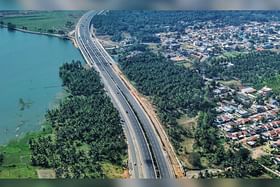Starting from 1 August, the National Highways Authority of India (NHAI) has implemented a ban on six types of vehicles on the Bengaluru-Mysuru Expressway.
This decision comes as a response to the rising number of accidents, some of which have been fatal. The vehicles prohibited from using the main carriageways include ban two-wheelers, three-wheelers, bullock carts, tractors, JCBs, and other slow-moving agricultural vehicles.
The NHAI explained their reasoning for the ban in a notification. They expressed concerns about the safety of slower-moving vehicles such as two-wheelers, three-wheelers, and non-motorised vehicles when sharing the road with high-speed vehicles.
The speed differentials between these vehicles could potentially compromise road safety. The NHAI assured that alternative routes and roads are available for the affected classes of vehicles.
According to the NHAI, the Bengaluru-Mysuru Expressway was designed as a high-speed corridor with varying speed limits for different types of vehicles, ranging from 80 km per hour to 100 km per hour, reports The Hindu.
To address the alarming number of accidents on the expressway, the police have taken action by deploying mobile speed radar guns. These devices are used to catch motorists who exceed the speed limit of 100 kmph.
Accidents on Bengaluru-Mysuru Expressway
The demand for this ban has been growing as the number of accidents on the Bengaluru-Mysuru Expressway has been steadily increasing. In a recent statement, Home Minister G. Parameshwara revealed that in the last four months alone, there have been 84 accidents resulting in 100 fatalities on the expressway. Additionally, over 300 people have been injured in 223 non-fatal accidents. These alarming statistics have prompted action to improve road safety.
On 5 July, the Karnataka state government informed the Legislative Council that accidents on the Bengaluru-Mysuru motorway claimed the lives of 20 persons on average each month. According to the state government, accidents on the highway resulted in up to 100 persons suffering serious injuries each month on average.
Between the months of January and June of this year, there were 512 accidents on the motorway. On the highway’s Bengaluru to Nidaghatta segment, there were 245 accidents, while the Nidaghatta to Mysuru portion saw 267 accidents. There have been 123 fatalities overall.
The highest number of accidents in a month was reported in May when 110 occurred.
According to the state administration, “lack of lane discipline and exceeding the speed limit of 100 kmph” were the primary causes of the incidents. The Ministry of Road Transport and Highways has proposed that two- and three-wheelers be banned on the expressway.
Bengaluru-Mysuru Expressway
The 10-lane expressway (two-lane service roads on both sides) was conceptualised and executed as two distinct packages: 58 km Phase-1 between Bengaluru and Nidaghatta and 61 km Phase-2 between Nidaghatta and Mysore.
The 118 km long project has been developed at a total cost of around Rs 8,480 crore.
The expressway will reduce the travel time between Bengaluru and Mysuru from around 3 hours to about 75 minutes. It will act as a catalyst for socio-economic development in the region.
The expressway comprises of 8-km-long elevated corridors, nine major bridges, 42 minor bridges, 64 underpasses, 11 overpasses, four Road-Over-Bridges (ROBs) and five bypasses.
The expressway comprises six bypasses at Bidadi (7 km), Ramanagara and Channapatna (22 km), Maddur (7 km), Mandya (10 km) and Srirangapatna (7km).
The expressway originates near the NICE Road on the outskirts of Bengaluru and terminates near the Outer Ring Road junction in Mysuru.


